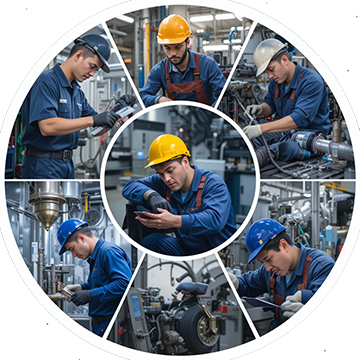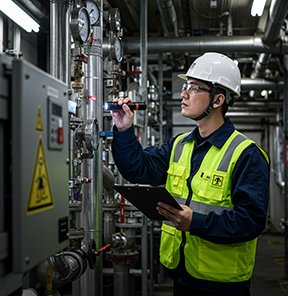Published: July 16, 2025 | Updated: October 23, 2025
Published: July 16, 2025 | Updated: October 23, 2025
10 Preventative Maintenance Types to Strengthen Your Maintenance Strategy
 Effective equipment and facility care serve as a cornerstone of operational success across countless industries. Proactive strategies maintain machinery and infrastructure, preventing unexpected disruptions. This discussion helps you understand ten key preventive maintenance types, illustrating their application with concrete examples and detailing the transformative influence of a Computerized Maintenance Management System.
Effective equipment and facility care serve as a cornerstone of operational success across countless industries. Proactive strategies maintain machinery and infrastructure, preventing unexpected disruptions. This discussion helps you understand ten key preventive maintenance types, illustrating their application with concrete examples and detailing the transformative influence of a Computerized Maintenance Management System.
Preventive maintenance represents a proactive approach to managing equipment and facilities. This methodology seeks to prevent breakdowns and failures before they happen. Preventive maintenance involves systematic inspections, thorough cleaning, proper lubrication, and other critical tasks that ensure assets operate effectively.
Let's begin with three fundamental types.
Inspections: A Foundational Preventative Maintenance Type
Regular inspections prove critical for identifying potential issues before they worsen. Two primary categories define these examinations:
- Equipment Inspections. These involve a detailed examination of machinery, checking for signs of wear, damage, or unusual operation.
- Asset Inspections. These concentrate on other physical assets, such as buildings, structural components, or vehicles.
Industry Applications of Inspections
In manufacturing, a food processing plant conducts weekly inspections of production lines. These inspections check for foreign objects, sanitation concerns, or machinery malfunctions. Within healthcare, a hospital performs monthly inspections of medical devices, including MRI machines, ensuring their precise calibration and overall safety. Calibration warrants further discussion.
Equipment & Facility Cleaning as a Maintenance Strategy
Cleaning eliminates contaminants and inhibits corrosion, which often causes equipment failures. This essential activity applies to both machinery and other assets.
- Equipment Cleaning. This includes removing dirt, grease, and other debris from machinery to maintain efficiency and prevent damage.
- Asset Cleaning. This involves cleaning facilities, such as offices or warehouses, creating a clean and safe environment.
Real-World Cleaning Practices
An automotive repair shop regularly cleans engine components. This practice removes carbon buildup and enhances performance. In the hospitality sector, a restaurant cleans kitchen equipment daily. This action prevents food contamination and upholds rigorous sanitation standards.
Lubrication: A Critical Type of Preventative Maintenance
Proper lubrication diminishes friction, wear, and heat in moving mechanical components. It helps avoid early failures and prolongs equipment lifespans.
- Equipment Lubrication. This involves applying the correct lubricant to bearings, gears, and other moving parts.
- Asset Lubrication. This includes lubricating door hinges, locks, or other moving components within buildings.
Lubrication Across Industries
Aviation companies conduct regular lubrication of aircraft engines, landing gear, and other crucial components. This practice ensures flight safety and dependable operation. In manufacturing, a factory utilizes automated lubrication systems. These systems guarantee consistent and timely lubrication of machinery.
Discover how streamlined maintenance processes can elevate production. Learn more.
Energy Monitoring: A Smart Maintenance Type for Efficiency
Monitoring energy usage helps reduce costs and promotes environmental sustainability.
- Energy Audits. These assess energy consumption patterns and identify areas for improvement.
- Energy-Efficient Upgrades. These involve replacing outdated equipment with more energy-efficient models. This might include upgrading lighting fixtures to LED bulbs to reduce energy consumption.
Examples of Energy Management
Data centers frequently implement energy-efficient cooling systems and power management strategies. These measures reduce their carbon footprint and operating expenditures. Retailers often install motion-activated lighting systems. This reduces energy consumption in unoccupied areas.
Proactive Repairs & Replacements in Preventative Maintenance
Predictive maintenance techniques, such as vibration analysis or infrared thermography, help identify components nearing failure. Replacing or repairing these components proactively avoids unplanned downtime and expensive repairs.
- Component Replacement. This involves replacing worn or damaged components before they fail.
- Preventive Repairs. These involve addressing minor issues before they worsen into major problems. For instance, a property management company might repair a leaky roof to prevent further damage and water infiltration.
Preventative Action in Practice
A manufacturing facility uses vibration analysis to monitor the health of critical components, such as bearings. They replace these components before failure occurs. A fleet operator utilizes predictive maintenance techniques to identify potential vehicle issues. This allows for proactive scheduling of repairs.
Calibration: Ensuring Precision and Accuracy
For equipment requiring precise measurements or adjustments, regular calibration assures accuracy and prevents errors. Medical devices like blood pressure monitors or laboratory equipment require periodic calibration to maintain reliability.
Calibration in Diverse Fields
In healthcare, medical devices such as X-ray machines, ultrasound equipment, and laboratory analyzers require regular calibration. This ensures accurate diagnoses and treatments. Precision machining equipment, including CNC machines and metrology tools, needs calibration in manufacturing. This maintains tolerances and produces high-quality products.
Software Updates: Digital Maintenance Strategy for Modern Systems
In today's digital landscape, software updates prove essential for security, performance, and compatibility. Regular updates prevent vulnerabilities and confirm equipment operates at its highest level.
Software Maintenance Across Sectors
IT departments regularly update computers, servers, and network devices. This addresses security vulnerabilities, improves performance, and ensures compatibility with other systems. Vehicles with advanced technology, including infotainment systems or driver-assistance features, need software updates. These updates address bugs, improve functionality, and keep features current.
Environmental Monitoring: Safeguarding Equipment in Challenging Conditions
For equipment operating in harsh environments, monitoring factors like temperature, humidity, or vibration helps identify potential issues and schedule maintenance accordingly. For example, outdoor equipment exposed to extreme weather conditions requires more frequent inspections and maintenance.
Environmental Considerations in Operations
In the oil and gas industry, equipment operating in harsh offshore environments, such as drilling rigs and pipelines, demands monitoring of factors like temperature, pressure, and corrosion. This prevents failures. Industrial facilities, particularly those in areas with extreme weather, monitor environmental factors. This confirms equipment operates reliably and efficiently.
Operator Training: A Human-Centered Preventative Maintenance Strategy
Ensuring that operators receive proper training on equipment usage and maintenance procedures helps prevent accidents, reduces equipment damage, and improves overall efficiency.
Training's Impact on Performance
Pilots and aircraft maintenance technicians receive ongoing training. This keeps them current on the latest safety procedures, equipment maintenance, and regulatory requirements. Factory workers receive training on proper equipment operation, safety procedures, and preventive maintenance tasks. This ensures efficient and safe production.
Safety Inspections: A Vital Maintenance Strategy for Risk Prevention
Regular safety inspections identify and address potential hazards before they lead to accidents or injuries. This includes checking for fire risks, electrical safety, and appropriate use of personal protective equipment (PPE).
Safety Across Industries
Construction sites require regular safety inspections. These inspections identify and address hazards like scaffolding instability, electrical dangers, and improper use of PPE. Hospitals and clinics conduct safety inspections to ensure compliance with regulations, prevent accidents, and protect patients and staff.
How CMMS Software Enhances Preventative Maintenance Strategies
 For numerous companies, CMMS software offers a path to maintenance management success. It organizes existing strategies by providing several key advantages:
For numerous companies, CMMS software offers a path to maintenance management success. It organizes existing strategies by providing several key advantages:
- Improved Efficiency. A CMMS consolidates maintenance processes, reduces paperwork, and improves communication between maintenance teams and other departments. This system replaces manual records with standardization and automation.
- Enhanced Compliance. Many preventive maintenance activities ensure regulatory compliance. A CMMS provides essential documentation for auditors.
- Reports/Data For Informed Decisions. A CMMS provides valuable data on equipment performance, maintenance history, and costs. Proper analysis of this data reveals opportunities for expense reduction and increased efficiency.
- Cost Reduction. By preventing equipment failures and reducing downtime, a CMMS helps organizations save money on maintenance costs.
- Increased Uptime. Effective preventive maintenance, supported by a CMMS, keeps equipment dependable. Unplanned downtime causes production delays. Preventive maintenance reduces these occurrences.
Building a Stronger Maintenance Strategy with Preventative Care
While this article highlights ten crucial types of preventive maintenance, many more exist, often depending on specific industry requirements. Nevertheless, a common purpose unites all preventive maintenance efforts: to proactively maintain assets and avoid costly, unexpected disruptions. With a CMMS, an organization gains superior oversight of its entire maintenance program. It offers better control over assets, inventory, and work orders. Within the preventive maintenance section, users list each job, its priority, type, location, and associated asset. They create cycles to maintain regular preventive maintenance schedules.
FAQs
What is preventive maintenance?
Preventive maintenance is a proactive approach to caring for equipment and facilities. It involves inspections, cleaning, lubrication, calibration, and other regular tasks to prevent breakdowns and extend asset life.
What are the main types of preventive maintenance?
Ten key types include inspections, cleaning, lubrication, calibration, proactive repairs, software updates, environmental monitoring, energy management, operator training, and safety inspections. Each type supports reliable and efficient operations.
How does preventive maintenance reduce downtime?
By addressing potential issues before failures occur, preventive maintenance minimizes unplanned breakdowns, enhances equipment reliability, and ensures consistent productivity.
What role does a CMMS play in preventive maintenance?
A Computerized Maintenance Management System (CMMS) streamlines preventive maintenance by automating schedules, tracking work orders, storing asset data, and generating performance reports for better decision-making.
Why is operator training important in preventive maintenance?
Proper training ensures operators handle equipment correctly, preventing misuse, reducing damage, and improving safety and operational efficiency.
How can MAPCON’s CMMS improve preventive maintenance strategies?
MAPCON’s CMMS centralizes maintenance operations, automates scheduling, tracks compliance, and delivers data insights that reduce costs, increase uptime, and strengthen overall preventive maintenance performance.
MAPCON | 800-922-4336
MAPCON CMMS software empowers you to plan and execute PM tasks flawlessly, thanks to its wealth of features and customizable options. Want to see it for yourself? Click the button below to get your FREE 30-day trial of MAPCON!
Try It FREE!